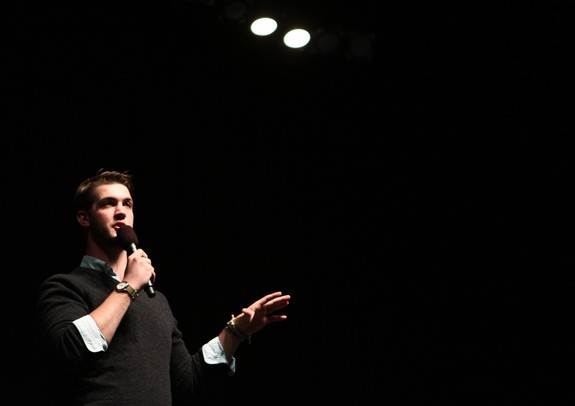ASPEN SANTA FE BALLET
Last weekend, the Aspen Santa Fe performed at the Power Center. It was a rainy Sunday and I spent the morning eating brunch at a hole-in-the-wall cake shop on the Old West Side called Jefferson Market and then watching the matinée performance. The indulgent outing felt both classic and obsolete: When was the last time I, a.) attended a ballet or b.) went to a matinée that was preceded by brunch on the town? My only justification was that going to the performance was required for my ballet class. But I am very glad that it was because the dance itself was truly a spectacle.
The show was visually stunning, incredibly professional, tightly rehearsed, and impressively physical. The presentation was a breath taking combination of artistry and athleticism that I have rarely seen. The costumes revealed a great deal of skin and muscle on both males and females that really made me wonder how many crunches they all do per day. Half the drama of the show was simply the chiseled appearance of their abs and buns. I’m serious.
The piece was comprised of three acts; Square None (2012), Stamping Ground (1983), and Over Glow (2011). Each act differed from the next in its score, its choreography, its costumes design, and its lighting scheme, but it was clear that they were intended to be a part of a unified, coherent performance.
The first piece used grey lighting and darker musical tones while the second used no music and bright lighting. The first two appeared to make commentary on modern culture: the first was structured around bionic, wind-up-doll-like gestures. The second was very animalistic and primitive, using the body as a drum to make rhythms rather than electronic sound. (The second piece was by far my favorite; it was the most animated, relatable, and story-like whereas the other were more theoretical and abstruse). The last piece was the prettiest, with pastel colors and graceful lifts, leaps, and pirouettes. It was lovely to watch, but was my least favorite act because it felt sort of flat in comparison to the creativity in the previous two.
One thing I have not mentioned yet is the fact that this kind of ballet is not like Swan Lake or The Nutcracker. It’s not classical ballet, its neo-classical; its contemporary. It uses the same structure and techniques as ballet (straight legs, delicate fingers, turned out feet) but also incorporates movement that more resembles modern dance. Contemporary ballet allows for a greater breadth of movement and does not adhere as strictly to the lines set forth by the original forms of classic ballet. In many ways, especially after seeing Aspen Santa Fe’s performance, I find myself drawn to this genre. It is still both pretty and recognizable, but also fluid, creative, and unusual.
Sunday brunch and a matinée at the Power Center is one of the easiest assignments I’ve ever been given. Oh, and one last fun fact about the costume design from Square None was that it was designed by Project Runway celebrity contestant Austin Scarlett. Who knew.




 Image from Rite of Spring
Image from Rite of Spring










